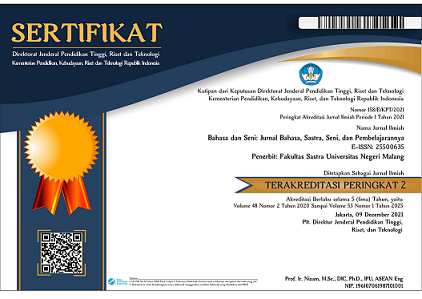Individual liaison: Gregorius Sidharta, tradition, and modernity
Abstract
Individual liaison: Gregorius Sidharta, tradition, and modernity
Understanding the dialogic relation between tradition and modernity in our current cultural dynamic remains an ‘incomplete project’ that requires careful examination. Approaching and thoroughly interpreting both roles in our society, mainly in how they influenced our current paradigm of culture, continue to pose risks and challenges. This article will explore the works of Gregorius Sidharta Soegijo, a renowned maestro of Bandung modern art, whose conversational practice proposes a particular means of harmonizing these antagonistic tensions and various derivatives issues that might later follow. By using art criticism as its primary modalities while simultaneously cross-referencing both modern and contemporary aesthetic paradigms, this article will demonstrate how Sidharta’s inclusive and deliberate approach might provide a dialogic site for various antagonist polarities—mainly tradition and modernity—to coexist within a democratic, horizontal, and productive axis. His audacity in contemplating inward and resorting to his idiosyncrasy would also be highlighted for its contributive nature as the pretext of his attempt to reconcile, resolve, and synthesize the long-desirable harmony between tradition and modernity. These gestures have undergone a consistent, gradual process of internal reflection that touched upon his personal experiences, particularly his encounter with multitudes of cultural values, perspectives, and paradigms that each proposes their significance.
Arbitrase individual: Gregorius Sidharta dalam dikotomi tradisi dan modernitas
Tradisi dan modernitas dalam kemutakhiran saat ini masih menyimpan banyak selubung pemaknaan yang menunggu untuk dibuka, didalami, dan dimaknai kembali. Mendekati dan memahami keduanya dengan adil dan menyeluruh adalah upaya yang beresiko. Gregorius Sidharta Soegijo, salah satu maestro patung modern Bandung, menunjukkan cara yang khas dalam menengahi beragam tegangan beserta ragam derivasi konflik yang dimunculkan. Dengan berpijak pada metode kritik seni terhadap sepilihan karya Sidharta untuk kemudian diperiksa secara menyilang baik terhadap konsep-konsep estetika modern serta kontemporer, artikel ini akan menunjukkan bagaimana Sidharta menemukan kesetimbangan untuk menghidupkan keduanya dengan berpijak pada idiosinkrasi diri untuk mempertemukan, mendamaikan, menengahi, serta melakukan arbitrase pada dikotomi tradisi dan modernitas. Keseimbangan ini ditemukannya melalui perkembangan pemaknaan diri yang secara gradual bersentuhan dengan beragam perbedaan nilai, paradigma, dan ideologi yang membawa keutamannya masing-masing.
Full Text:
PDFReferences
Anindita, P. (2020). G. Sidharta Soegijo: Merengkuh yang lalu dan kini. Direktorat Kesenian, Direktorat Jenderal Kebudayaan, Kementerian Pendidikan dan Kebudayaan Indonesia.
Barrett, T. (2004). Criticizing art: Understanding the contemporary (TH Lee, Trans.) ((2nd ed.)). ArtBooks (Original work published 2000).
Fakih, F. (2012). Conservative corporatist: Nationalist thoughts of aristocrats: The ideas of Soetatmo Soeriokoesoemo and Noto Soeroto. Bijdragen Tot de Taal-, Land-En Volkenkunde/Journal of the Humanities and Social Sciences of Southeast Asia, 168(4), 420–444. http://www.jstor.org/stable/23339341
Feldman, E. B. (1967). Art as image and idea. Prentice-Hall.
Greenberg, C. (1971). Art and culture: Critical essays (Vol. 212). Beacon Press.
Gumilar, G. (2018). Wacana seni rupa kontemporer dalam penyelenggaraan bienal di Indonesia pada periode 1993-2003 [Institut Teknologi Bandung]. https://digilib.itb.ac.id/index.php/gdl/view/27455
Hapsoro, C. D., & Wiyanto, H. (2020). Pusaka seni rupa: Seni patung Indonesia modern. Direktorat Kesenian, Direktorat Jenderal Kebudayaan, Kementerian Pendidikan dan Kebudayaan Indonesia.
Holt, C. (1967). Art in Indonesia: continuities and change. Cornell University Press.
Kusmara, A. R. (2011). Medium seni dalam medan sosial seni rupa kontemporer Indonesia. Disertasi Program Doktor Ilmu Seni Rupa dan Desain, Institut Teknologi Bandung.
Lanti, I. G., & Dermawan, W. (2020). Examining the growth of islamic conservatism in Indonesia: The case of West Java. In Rising Islamic Conservatism in Indonesia (pp. 54–79). Routledge. http://www.jstor.org/stable/resrep19934
Lyotard, J.-F. (1979). 1984: The postmodern condition: A report on knowledge. Trans. Geoff Bennington and Brian Massumi. Minneapolis: University of Minnesota Press.
Munroe, A. (1997). Contemporary art in Asia: Traditions/tensions. Artforum, 35(8), 8. https://www.artforum.com
Poshyananda, A. (1996). Contemporary art in Asia: Traditions, tensions. Craftsman House. https://greyartgallery.nyu.edu/exhibition/traditionstensions-100396-122396/
Pribadi, Y. (2021). Rising Islamic conservatism in Indonesia: Islamic groups and identity politics. 29(4). doi: 10.1080/0967828X.2021.2009255
Smith, T. (2011). Currents of world-making in contemporary art. World Art, 1(2), 171–188.
Sudjoko, S. (1992). Menuju nirada. Galeri Nasional Indonesia.
Supangkat, J. (1995). Lukisan, patung, dan grafis G. Sidharta. Rekamedia Multiprakarsa.
Supangkat, J. (2001). Outlet: Yogyakarta within the contemporary Indonesian art scene (C. A. Foundation (ed.)). Cemeti Art Foundation.
Supangkat, J., & Yuliman, S. (1982). Gregorius Sidharta di tengah seni rupa Indonesia. Gramedia.
Supriyadi, J., Sabana, S., & Adriati, I. (2012). Kesadaran mental-kultural perupa dalam praktek seni rupa kontemporer Indonesia: Refleksi dalam kajian karya dan perupa G. Sidharta Soegijo. Seminar Internasional Warisan Nusantara Indonesia 2012.
Wallis, B., Acker, K., Baudrillard, J., Borges, J. L., Crary, J., Foster, H., Hoberman, J., Jameson, F., Krauss, R., & Lawson, T. (1984). Art after modernism: Rethinking representation. The New Museum of Contemporary Art.
Yuliman, S. (1990). Metafora untuk metropol. Tempo.
Zaelani, R. (2021). Kelahiran seorang dewi: Imaginary dialogues with G. Sidharta Soegijo. Artsociates - Lawangwangi.
DOI: http://dx.doi.org/10.17977/um015v50i22022p176
Refbacks
- There are currently no refbacks.

This work is licensed under a Creative Commons Attribution 4.0 International License.

Dear Sir/Madam
We appreciate your continued confidence and trust in Bahasa dan Seni: Jurnal Bahasa, Sastra, Seni, dan Pengajarannya (JBS). In order to enhance the service, readability, and quality of JBS publications, we will be transitioning to a new website, https://citeus.um.ac.id/jbs, in collaboration with Digital Commons (Elsevier) starting in July 2024.
Sincerely
Yusuf Hanafi
(Editor in chief)
















2.png)